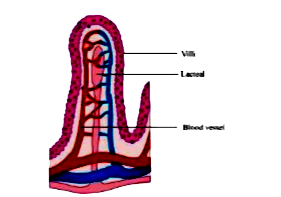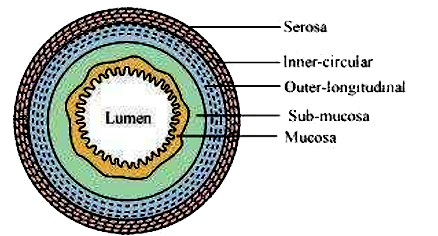Answer briefly:
(a) Why are villi present in the intestine and not in the stomach?
(b) How does pepsinogen change into its active form?
(c) What are the basic layers of the wall of alimentary canal?
(d) How does bile help in the digestion of fats?

(a) The mucosal wall of the small intestine forms millions of tiny finger-like projections known as villi. These villi increase the surface area for more efficient food absorption.
Within these villi, there are numerous blood vessels that absorb the digested products of proteins and carbohydrates, carrying them to the blood stream. The villi also contain lymph vessels for absorbing the products of fat-digestion. From the blood stream, the absorbed food is finally delivered to each and every cell of the body. The mucosal walls of the stomach form irregular folds known as rugae. These help increase the surface area to volume ratio of the expanding stomach.
(b) Pepsinogen is a precursor of pepsin stored in the stomach walls. It is converted into pepsin by hydrochloric acid. Pepsin is the activated in the form of pepsinogen.
Pepsinogen (Inactive)HCL−−→Pepsin(Active)+Inactive peptide
(c) The walls of the alimentary canal are made up of four layers. These are as follows:

(i) Serosa is the outermost layer of the human alimentary canal. It is made up of a thin layer of secretory epithelial cells, with some connective tissues underneath.
(ii) Muscularis is a thin layer of smooth muscles arranged into an outer longitudinal layer and an inner circular layer.
(iii) Sub-mucosa is a layer of loose connective tissues, containing nerves, blood, and lymph vessels. It supports the mucosa.
iv. Mucosa is the innermost lining of the lumen of the alimentary canal. It is mainly involved in absorption and secretion.
(d) Bile is a digestive juice secreted by the liver and stored in the gall bladder. Bile juice has bile salts such as bilirubin and biliverdin. These break down large fat globules into smaller globules so that the pancreatic enzymes can easily act on them. This process is known as emulsification of fats. Bile juice also makes the medium alkaline and activates lipase.
Topper's Solved these Questions
Similar Questions
Answer brief :
(i) Why are villi present in the intestine and not in stomach?
(ii) How does pepsinogen change into its active form?
(iii) What are the basic layers of the wall of alimentary canal?
(iv) How does bile help in digestion of fat?View SolutionDescribe the following processes in the body.
(a) Coagulation of milk in alimentary canal.
(b) Digestion of fats in the intestine.
(c ) Digestion of starch in the alimentary canal.
(d) Role of bile salts in the digestion and absorption of fats.
(e ) Microbial digestion of cellulose in the herbivore alimentary canal.View Solution
Knowledge Check
- Question 1 - Select One
Given below are assertion and reason. Point out if both are correct with reason being correct explanation (A), both true but reason is not correct explanation (B), assertion true but reason is wrong (C), both are wrong (D). Assertion. Thick layers of muscles are present in the wall of alimentary canal. Reason. These muscles help in mixing of food materials with enzymes coming from glands of alimentary canal.Â
AABBCCDD
Read the following passage carefully and answer the questions that follows it.
Bile juice is stored in a sac called gall bladder, located near its organ of secretion, liver. The gall bladder releases the bile juice into the small intestine whenever food reaches there. Though bile juice is devoid of any digestive enzymes, it is required for the digestion of fats. The fats cannot be digested easily because they are insoluble in water and are present as large globules. Bile juice breaks down big fat droplets into smaller droplets. These are then easily digested by the enzymes released from the pancreas.
(a) Which organ secretes the bile juice ?
(b) Why is digestion of fats difficult as compared to that of other nutrients ?
(c ) How does bile juice help in digestion of fat ?
(d) Where is the digestion of fat completed ?
(e ) Does bile juice digest fat completely ?View SolutionExplain the following :
(a) How does the middle ear help in hearing ?
(b) Why does vitamin A deficiency produce night-blindness ?
(c ) What is the role of lacrimal gland ?
(d) How does the iris adjust the size of the pupil ?View SolutionIn the dry cell
(a) Which substance acts as anode and which as cathode ?
(b) Which electrolyte is used in the cell ?
(c ) What is the cell potential of the cell ?
(d) Why does the cell voltage not change during operation ?
 View Solution
View SolutionThe concept of energy and its trnasformation is useful in explaining and predicting most natural phenomena. (a) What is the concept of energy in the context of chemistry ? (b) How do we associate energy with biology ? (c ) What is the roal of energy transformations in geology ? (d) What role does energy play in life ?
View SolutionAnswer the following questions :
(a) What would be the consequences if there was no planning ?
(b) How does planning provide the basis of control ?
(c) What does 'primary of planning' refer to ?
(d) Why is planning an intellectrual activity of thinking rather than doing ?
(e) Can planning eliminate changes/uncertain events? Give reason.View SolutionAnswer briefly :
(a) How do you perceive the colour of an object ?
(b) Which part of our body helps us in maintaining the body balance ?
(c) How does the eye regulate the amount of light that falls on the retina.View SolutionAnser simply as, a,b,c or d
(i) Sucrase in an enzyme found in
(a) Saliva (b) Gastric juic (c ) Intertinal juice (d) Panceatic juice
(ii) Most digestion occurs in
(a) Mouth (b) stomach (c ) small intestine (d) Large intestine
(iii) What is the substrate of salivary amylase?
(a) Protein (b) starch (c) Glucose (d) maltose
(iv) The funcitons of bile are listed below. Pick out the false statement
(a) Bie neutralses the acidic of food
(b) It provides an alkaline medium for the interstinal proteases
(c ) It contains a lipase (d) Its salt emulsify fats.View Solution

